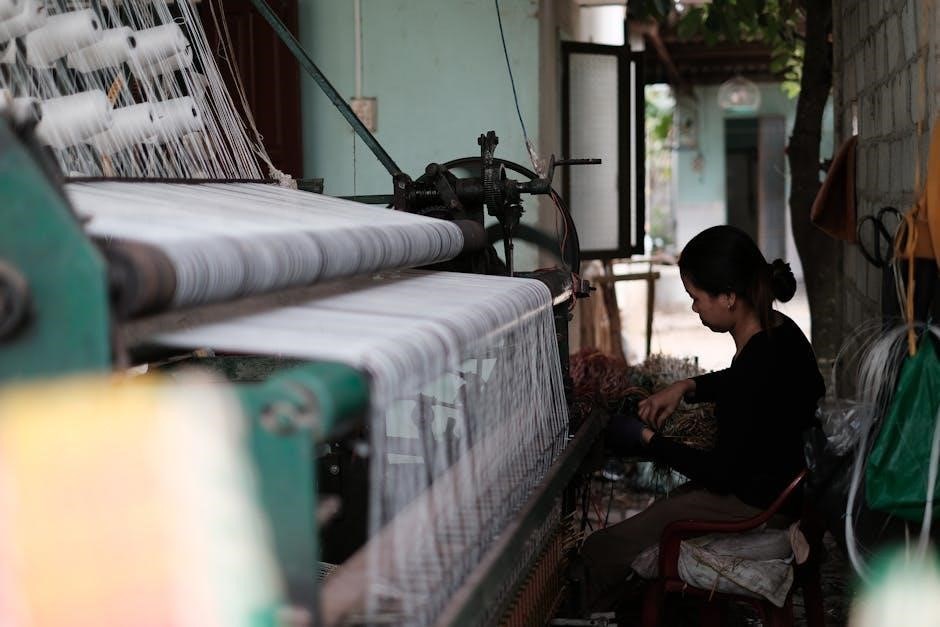
The Singer 500A manual is essential for optimal use, providing detailed guidance on machine parts, threading, and troubleshooting. It ensures users maximize the machine’s capabilities and longevity.
1.1 Overview of the Singer 500A Sewing Machine
The Singer 500A is a vintage sewing machine renowned for its durability and versatility. Designed for both home and professional use, it features a heavy-duty metal frame, making it suitable for various fabrics. The machine offers multiple stitch options, including straight and zigzag stitches, and is known for its smooth operation. Its compact design and user-friendly interface make it a favorite among sewists; The Singer 500A manual provides detailed instructions for setup, maintenance, and troubleshooting, ensuring optimal performance. Reprints and digital versions of the manual are widely available, maintaining its accessibility for modern users.
1.2 Importance of the Manual for Optimal Usage
The Singer 500A manual is crucial for unlocking the machine’s full potential. It provides detailed instructions for setup, maintenance, and troubleshooting, ensuring users can address issues promptly. The manual also explains how to utilize various stitch options and customize settings for different fabrics. By following the guide, users can extend the machine’s lifespan and achieve professional-grade results. Whether you’re a beginner or an experienced sewist, the manual serves as an indispensable resource for mastering the Singer 500A’s capabilities and maintaining its performance over time.
History and Background of the Singer 500A
The Singer 500A traces its legacy to Isaac Singer’s 1851 patent, marking the beginning of practical sewing machines. Introduced in the mid-20th century, the 500A became a beloved vintage model, renowned for its durability and versatility, embodying Singer’s commitment to innovation and quality.
2.1 Evolution of Singer Sewing Machines
The Singer sewing machine evolved significantly from Isaac Singer’s 1851 patent, which revolutionized sewing. Over the decades, Singer introduced mechanical innovations, transitioning from heavy industrial models to portable, user-friendly designs. The Singer 500A emerged in the mid-20th century, embodying this progression with its robust construction and versatile features. This model became a symbol of Singer’s commitment to quality and innovation, catering to both home sewists and professionals. Its enduring popularity highlights the company’s ability to adapt to changing sewing needs while maintaining exceptional performance and reliability.
2.2 Key Features of the Singer 500A Model
The Singer 500A is renowned for its durability and versatility, featuring a heavy-duty metal frame and a powerful motor. It offers a variety of stitch options, including straight and zigzag stitches, making it suitable for diverse sewing projects. The machine’s design emphasizes ease of use, with clear controls and a user-friendly interface. Additionally, the 500A is compatible with multiple accessories, enhancing its functionality for both basic and advanced sewing tasks. Its robust construction ensures long-lasting performance, making it a reliable choice for sewists of all skill levels.
Understanding the Singer 500A Manual

The Singer 500A manual is a comprehensive guide offering clear instructions, detailed diagrams, and troubleshooting tips. It helps users master machine operations and maintenance effectively.
3.1 Structure and Content of the Manual
The Singer 500A manual is structured to guide users through setup, operation, and maintenance. It includes sections on machine parts, threading, stitch selection, and troubleshooting. Clear illustrations and step-by-step instructions ensure ease of understanding. The manual also covers essential accessories and customization options, making it a comprehensive resource for both beginners and experienced sewists. Available in PDF format, it can be downloaded from sources like ManualsLib or purchased as a high-quality reprint from eBay sellers, ensuring accessibility for all users.
3.2 Navigating the Manual for Beginners
Beginners can easily navigate the Singer 500A manual by starting with the basics section, which explains machine parts and essential functions. The manual is organized logically, with clear headings and illustrations. Users should begin by reading the manual front-to-back to familiarize themselves with its structure. Practicing each function as described helps build confidence. Additionally, online communities like Reddit’s r/vintagesewing offer support for beginners, while video tutorials provide visual guidance. This approach ensures a smooth learning curve for mastering the Singer 500A.
Parts and Accessories of the Singer 500A
The Singer 500A manual includes a comprehensive list of machine parts and accessories, with detailed diagrams to help users identify and understand each component for optimal functionality.
4.1 Comprehensive List of Machine Parts
4.2 Essential Accessories for Enhanced Functionality
The Singer 500A manual highlights key accessories that enhance sewing efficiency, such as various presser feet for zippers, buttons, and embroidery. Additional bobbins, needles, and thread guides are also recommended. Specialized feet like the walking foot or Teflon foot improve handling of thick or delicate fabrics. These accessories, available on eBay and Singer’s official website, ensure versatility and precision in sewing projects. The manual provides guidance on selecting and using these tools effectively, empowering users to explore advanced techniques and expand their creative possibilities with ease and confidence.

Threading and Bobbin Setup
The Singer 500A manual provides essential guidance on threading and bobbin setup, ensuring smooth sewing operations. Proper techniques are crucial for optimal performance and fabric handling.

5.1 Step-by-Step Guide to Threading the Machine
- Locate the spool pin and ensure the machine is turned off.
- Insert the thread through the spool pin and guide it through the tension discs.
- Pass the thread through the take-up lever and then through the needle.
- Gently pull the thread to ensure it is seated properly.
- Refer to the manual for detailed diagrams to confirm correct threading.
- Test the machine by sewing a few stitches to ensure smooth operation.
Proper threading is essential for consistent stitching and machine performance.
5.2 Proper Bobbin Installation Techniques
- Lift the needle to its highest position and remove any remaining thread.
- Open the bobbin case and insert the bobbin, ensuring the thread rotates counterclockwise.
- Gently pull the thread to seat the bobbin correctly.
- Close the bobbin case and test by sewing a few stitches.
Proper bobbin installation ensures smooth stitching and prevents machine jams or thread breakage.

Maintenance and Troubleshooting
Regular cleaning and oiling ensure smooth operation. Check for loose screws and thread breakage. Addressing issues promptly prevents damage and extends the machine’s lifespan effectively.
6.1 Regular Maintenance Tips
Regular maintenance ensures the Singer 500A runs smoothly. Clean the machine thoroughly, oil moving parts, and check for loose screws; Replace worn or damaged components promptly. After heavy use, inspect the bobbin area and tension discs for thread residue. Refer to the Singer Help Center or official manuals for detailed cleaning and lubrication instructions. Proper care extends the machine’s lifespan and prevents mechanical issues. Always use Singer-recommended products for maintenance to avoid damaging the machine. Regular upkeep ensures consistent performance and stitch quality.
6.2 Common Issues and Solutions
Common issues with the Singer 500A include thread bunching, machine noise, or bobbin jams. For thread bunching, rethread the machine and ensure the tension is balanced. If the machine is noisy, check for loose parts or insufficient oil. Apply Singer-recommended oil to moving components. For bobbin jams, clean the bobbin area and ensure proper alignment. Refer to the Singer Help Center or official manuals for detailed troubleshooting. Addressing these issues promptly ensures smooth operation and prevents further damage. Always use genuine Singer parts for repairs to maintain performance and longevity.

Stitch Selection and Customization
The Singer 500A offers versatile stitch options, allowing users to customize length, width, and type for various fabrics and projects, enhancing creativity and precision in sewing tasks.
7.1 Available Stitch Options
The Singer 500A offers a wide range of stitch options, including straight stitch, zigzag, and decorative stitches, catering to various sewing needs. Users can select from multiple stitch types, each designed for specific fabrics and techniques. The machine also features adjustable stitch length and width, allowing for precise customization. This versatility makes it ideal for both basic and intricate projects, ensuring high-quality results. Whether sewing denim, silk, or embroidery, the 500A’s stitch variety provides the flexibility to tackle any task with ease and professionalism.
7.2 Adjusting Stitch Length and Width
The Singer 500A allows precise adjustment of stitch length and width, enhancing customization for various fabrics and techniques. Users can easily modify these settings using the machine’s control dials. Adjusting the stitch length ensures proper fabric movement, while altering the width adds decorative flair or accommodates thicker materials. These features provide flexibility, enabling users to achieve professional results in embroidery, quilting, or everyday sewing. The machine’s intuitive controls make it simple to fine-tune stitches, ensuring optimal performance for any project.

Tips for Beginners

Start with simple projects, practice threading, and use scrap fabric. Refer to the manual for clear guidance and avoid common mistakes by following step-by-step instructions carefully.
8.1 Getting Started with Your First Project
Begin by thoroughly reading the Singer 500A manual to understand basic operations. Start with a simple project, like a straight stitch on scrap fabric. Practice threading and bobbin installation as guided. Choose a straightforward pattern to build confidence. Use the manual’s diagrams to identify parts and ensure proper setup. Keep fabric steady and maintain a consistent pace. Don’t hesitate to refer back to troubleshooting tips if issues arise. Patience and practice will help you master your first sewing project with ease.
8.2 Avoiding Common Mistakes
Common mistakes with the Singer 500A often involve improper threading or bobbin alignment. Always ensure the bobbin is correctly seated and thread is evenly tensioned. Incorrect stitch selection can lead to poor results, so double-check settings before sewing. Keep fabric steady and avoid pulling it forcefully. Regularly clean lint buildup to prevent mechanical issues. Refer to the manual for troubleshooting guides if errors occur. Patience and attention to detail will help you avoid these pitfalls and achieve professional-looking results with your Singer 500A sewing machine.

Where to Find the Singer 500A Manual
The Singer 500A manual is available on the official Singer website, The Old Singer Shop, and eBay. It can also be downloaded as a free PDF online.
9.1 Official Singer Website and Resources
The official Singer website offers a comprehensive resource section where users can download the Singer 500A manual for free. The website provides detailed setup guides, maintenance tips, and troubleshooting instructions. Additionally, it features a help center with FAQs and video tutorials. Users can also find links to authorized dealers and a store locator to purchase accessories or find repair services. The official Singer website is the most reliable source for accurate and up-to-date information on the Singer 500A sewing machine.
9.2 Third-Party Sources and Communities
Beyond the official Singer website, third-party sources like eBay and specialized sewing communities offer valuable resources. Reddit’s r/vintagesewing provides user-generated tips and support for the Singer 500A. eBay sellers offer high-quality reprints of the manual, ensuring clarity and durability. Additionally, The Old Singer Shop provides detailed service manuals and parts guides. These third-party sources are ideal for enthusiasts seeking rare or hard-to-find documentation, fostering a sense of community and shared knowledge among Singer 500A users.
Comparison with Other Singer Models
The Singer 500A stands out among other models like the 500 and 503, offering unique features while maintaining Singer’s legacy of durability and precision in sewing.
10.1 Differences Between 500 and 500A
While the Singer 500 and 500A share a similar base design, the 500A offers enhanced features such as an automatic bobbin and additional stitch options. The 500A is tailored for heavier-duty projects, making it more versatile for advanced users. Both models emphasize durability and precision, but the 500A includes improvements that cater to those seeking more functionality. The manual highlights these distinctions, ensuring users can fully utilize the 500A’s advanced capabilities compared to the standard 500 model.
10.2 How the 500A Compares to Modern Models
The Singer 500A, while robust and reliable, differs from modern models in its mechanical simplicity. Contemporary machines often feature computerized controls, automatic threading, and a wider range of stitch options. The 500A’s metal frame and durability are reminiscent of classic designs, whereas modern models may prioritize portability and advanced features. Despite these advancements, the 500A remains a favorite among enthusiasts for its timeless performance and ease of maintenance, making it a bridge between vintage craftsmanship and modern convenience.
The Singer 500A manual is a vital guide for unlocking the machine’s full potential, ensuring durability and versatility for both beginners and experienced sewists.

11.1 Summary of Key Points
The Singer 500A manual is a comprehensive guide offering detailed insights into machine operation, maintenance, and troubleshooting. It covers essential topics like threading, bobbin setup, and stitch customization, ensuring users can fully utilize the machine’s features. Available on Singer’s official website and third-party sources, the manual is a vital resource for both beginners and experienced sewists, providing clear instructions to enhance sewing experiences and maintain the machine’s longevity.
11.2 Final Thoughts on the Singer 500A Manual
The Singer 500A manual is an invaluable resource for sewists, offering clear, detailed guidance to unlock the machine’s full potential. Its availability on Singer’s official website and third-party platforms ensures easy access. High-quality reprints and coil-bound designs enhance usability, making it a must-have for both beginners and experienced users. By following the manual, users can ensure proper setup, maintenance, and troubleshooting, fostering a seamless and enjoyable sewing experience.

